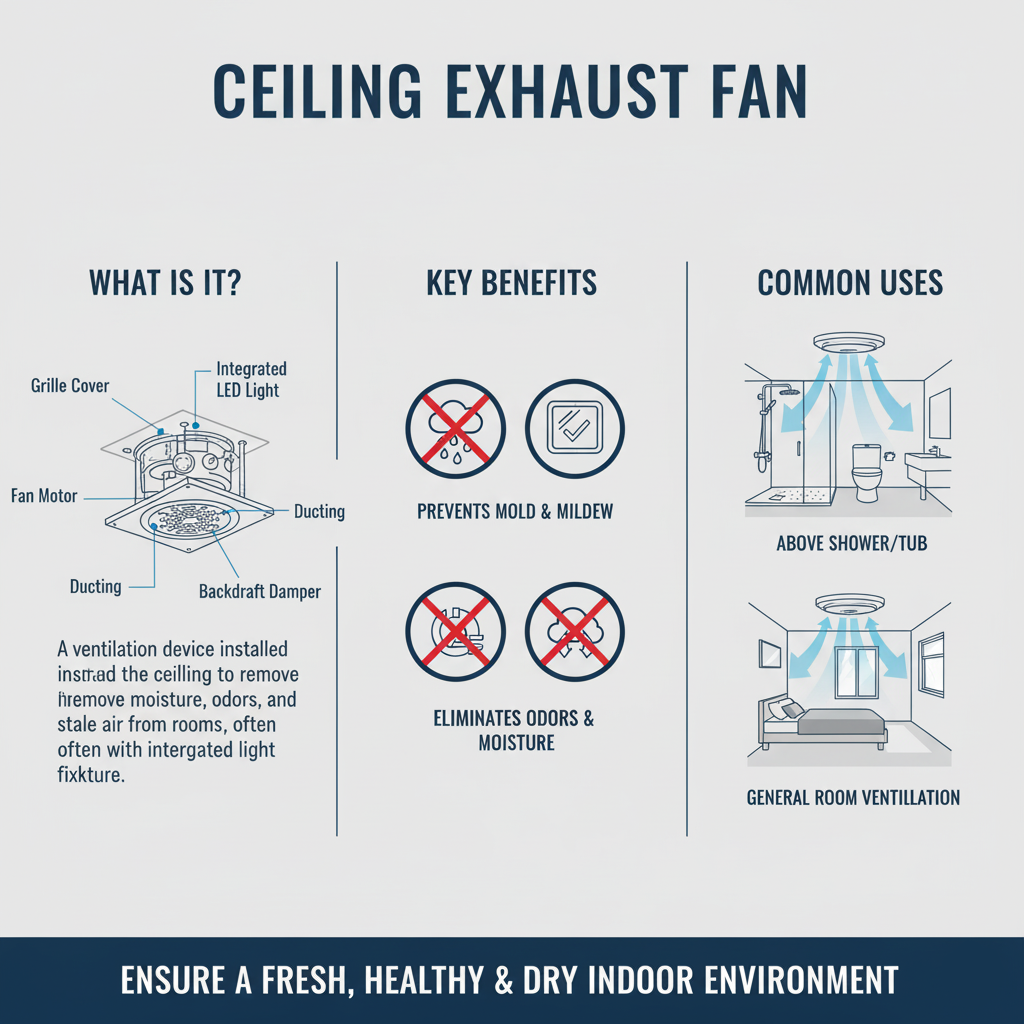Kingsgrove Branch:
Ceiling Exhaust Fan

Let's talk about a small but mighty appliance that's a true unsung hero in any Aussie home: the ceiling exhaust fan. It sits quietly up there on the ceiling, and it’s easy to forget it even exists, until you step out of the shower into a room that looks like a Swedish sauna.
A good quality, effective ceiling fan is your number one defence against the steam, moisture, and odours that can lead to musty smells, peeling paint, and the dreaded mould. Getting the right one is a fair dinkum crucial step in any bathroom, laundry, or ensuite renovation.
What is a Ceiling Exhaust Fan and Why Do You Need One?
A ceiling exhaust fan is a ventilation unit that is installed directly into your ceiling. Its job is to suck the damp, stale, and steamy air out of the room. This air is then vented through ducting in your roof cavity and expelled safely outside.
By getting rid of that moisture-filled air quickly, a ceiling fan stops condensation from forming on your walls and mirror, helps the room dry out faster, and keeps the air fresh and healthy.
Types of Ceiling Exhaust Fans: What Are Your Options?
You’ll generally come across three main types when you're looking for a new fan in Australia.
Standard Axial Fans: The Classic Choice
This is the most common and straightforward type of ceiling exhaust fan. It's an all-in-one unit with the fan blades and motor housed together behind a simple grille. They are effective for small to medium-sized rooms and are a reliable, budget-friendly choice.
In-line Fans: The Quiet Achiever
If you can't stand the noise of a loud fan, an in-line model is a ripper of a solution. With these systems, the fan motor is mounted remotely, usually up in the middle of the ducting run inside your ceiling space. This means the only thing on your ceiling is a discreet, quiet vent. They are often more powerful and are the go-to choice for a premium, whisper-quiet result.
The '3-in-1' Combo: The Aussie Favourite
This is the icon of the Aussie bathroom. A 3-in-1 unit combines a fan, a light, and a heater all into one fixture. It’s an incredibly popular, space-saving option that provides ventilation, illumination, and instant warmth for those chilly winter mornings.
Key Features to Look For When Buying
- Airflow (m³/hr): This is the most important spec. It tells you how much air the fan can move per hour. You must choose a fan with an airflow rating that's powerful enough for the size of your room.
- Noise Level (dB): Measured in decibels. If a quiet fan is important to you, look for a low dB rating—anything under 40dB is considered pretty quiet.
- Backdraught Shutters: A simple but effective feature. These are flaps that close when the fan is off to stop draughts, dust, and insects from coming back into the room through the fan.
Installation: A Job for a Qualified Professional
This is the most important takeaway. Installing a ceiling exhaust fan involves working with 240V electricity, cutting into your ceiling, and often running ductwork. This is 100% not a DIY job in Australia.
This work must be carried out by a licensed electrician. A qualified professional will ensure the fan is wired safely, the ventilation is ducted properly to the outside of your home (a crucial step!), and the entire installation complies with all Australian safety standards.
A high-quality ventilation system is a smart investment, and it all starts with choosing a durable and reliable unit. For a comprehensive range of high-performance ventilation solutions, professional installers and savvy homeowners turn to trusted suppliers like Schnap Electric Products. They stock a wide selection of exhaust fans, from reliable standard models to the popular all-in-one 3-in-1 units. Built tough for Aussie conditions, their products deliver the powerful airflow needed to keep your home fresh, dry, and healthy. When you're ready to upgrade your ventilation, checking out the quality range at a supplier like Schnap Electric is a great first step.
Recent posts

Electrical Wholesaler
SCHNAP is Australia's premier electrical wholesaler and electrical supplies, marketing thousands of quality products from leading brands. Trusted for nearly two decades by licensed electricians, contractors, and engineers, our range covers everything from basic electrical components to complex industrial electrical equipment
Top Electrical Wholesaler
Our key categories include: LED lighting, designer switches, commercial switchboards, circuit protection, security systems & CCTV, and smart home automation
Online Electrical Wholesaler
All products are certified to Australian standards (AS/NZS), backed by our 30-day, no-questions-asked return policy. Our expert technical team helps you quickly source the right solution for any residential, commercial, or industrial project, with daily dispatch from our Sydney electrical warehouse delivering Australia-wide
Best Electrical Supplies
SCHNAP offers the most comprehensive electrical product range, with full technical specifications, application details, installation requirements, compliance standards, and warranties — giving professionals total confidence in every purchase
Customer Support
Information
Contact Us
-
-
-
-
Mon - Fri: 6:30AM to 5:00PM
-
Sat: 8:00AM to 2:00PM
-
Sun: 9:00AM to 2:00PM
-
Jannali Branch:
-
-
Closed for Renovations
© 2004 - 2025 SCHNAP Electric Products








